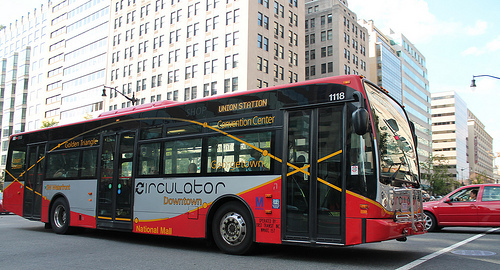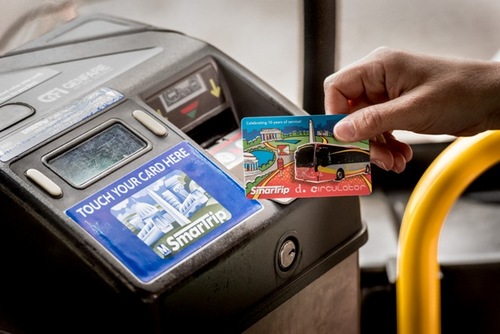The DC Circulator isn’t a waste of taxpayer money. In fact, some argue it’s too cheap.
Is the DC Circulator, the District’s red bus that plies central DC corridors (and a few other spots), a bad deal for taxpayers? Washington Post columnist Colbert King argues as much in a recent piece, but here’s the thing: for a bus, the Circulator is actually cheap, and some of the other things people criticize are consequences of using the lowest bidder.
King criticizes how DC’s latest budget adds funding for Circulator capital needs and operating costs, which have grown as the Circulator system has grown. He writes:
From 2011 to 2016, the District has funded the D.C. Circulator Operating/Capital Budget to the tune of $152.9 million (2011, $16.7 million; 2012, $12.6 million; 2013, $14.5 million; 2014, $27.2 million; 2015, $33.1 million; and 2016, $48.7 million).
A recent audit of the Circulator fleet found examples of neglected maintenance, engine defects, windows that wouldn’t open and other safety problems. So, the 2017 budget passed by the D.C. Council this week provides $34.5 million for Circulator buses and fleet rehabilitation.
The financial impact of the Circulator on D.C. wallets is a head-turner.
Is $48.7 million a lot or a little?
Can you name the operating cost of any other bus line? No? If not, do you have any idea if this number is high or low?
Too often, news stories and headlines present dollar figures for public works in a vacuum, devoid of context. To many people, 8-figure numbers just sound really high, whether or not they really are.
King also suggests that DC taxpayers are getting a bad deal because the District, rather than WMATA, owns the buses. But what he doesn’t say in the column is that DC saves money by not using WMATA.
The cost DC pays for Circulator service in 2013 was $83.20 per “revenue hour” (each hour a bus is running when it can carry passengers) in 2011. Metrobus’s cost per revenue hour in 2011 was somewhere between $93 and $142 per hour.1
This is a big reason why DC isn’t the only jurisdiction to run its own buses alongside Metro’s; just about all of them do.

Photos by Dan Malouff.
It’s cheaper because the contractor is stingier
So why is WMATA more expensive? Some of the cost may be inefficiencies from a large bureaucracy, but there’s also cost savings from stingier paychecks and skimpier benefits at First Transit, the contractor DC uses.
There’s been a lot of criticism of labor practices and poverty wages there. Labor-aligned groups have argued that Circulator drivers made far below a living wage for the Washington region. And a damning audit found major problems with the buses’ maintenance, as King points out in the excerpt above.
Drivers said First Transit was forcing them to take buses out with safety defects, a practice which is now prohibited in a new contract. The drivers also got a pay raise.
The company also recently came under fire for a policy against hiring ex-offenders. King mentions this as one criticism of the Circulator. (WMATA has some rules against hiring ex-offenders too, though I haven’t seen a detailed comparison of the hiring rules between the various companies.)
This situation isn’t just a coincidence. DC bid out operations for the Circulator, and paying less and cutting corners are some of the ways operators like this cut costs to get lower bids.
King criticizes First Transit for employing more Marylanders than DC residents. But if cost is such a major concern, it’s worth considering that hiring more DC residents would certainly drive up the cost of the contract. This is an instance of public policy where we can’t have it both ways — both lower costs and more DC hiring.
Yes, it would be better for more bus drivers to live in the jurisdictions where they drive, but to do that, DC will first need to add housing, including affordable housing, so more bus drivers can live in DC.
Expanding to more neighborhoods made the price go up
King also suggests that it’s wrong for the Circulator to stay in DC’s core (mostly). He writes, “most D.C. taxpayers, from Tenleytown, to Shepherd Park, to Woodridge, to Fort Lincoln, don’t know” the District owns the buses.
At the same time, his list of annual Circulator costs makes it looks like the the price tripled. But that’s at the same time DC expanded service to more areas. Some of those cost a lot more than the core lines. Here’s a graph of the farebox recovery rate by line for March 2015-February 2015 (the latest 12 months where the Circulator dashboard has data):
By far, the two lines that recouped less of their costs were Union Station to Navy Yard and Potomac Avenue-Skyland. The latter was a largely political move to ensure the “Circulator” went east of the Anacostia. While neighborhoods east of the river deserve better bus service, the Circulator probably wasn’t the right kind of bus service (Metrobus is).
That doesn’t mean other neighborhoods shouldn’t get better bus service. Ward 5 Councilmember Kenyan McDuffie recently fought for a new express bus along Rhode Island Avenue, which is great for residents of that corridor. Good for him. He was also right to not ask for it to be called the Circulator. Not everyone needs their bus to have the same name. What they all need and deserve is good bus service.
Why is the fare only $1?
A more reasonable argument from the column is about the fare. The Circulator costs $1. Metrobus costs $1.75. King criticizes this disparity, and I agree that’s not really fair. Why should neighborhoods with “Circulator” have a cheaper bus than neighborhoods with “Metrobus”?
Some lower-income people take the Circulator instead of a Metrobus because it’s cheaper, even if it’s not as convenient. It’s not sensible to push people to take one bus over another in this way. Though raising the Circulator fare wouldn’t help those folks, of course.
King also argues that tourists or more affluent people could afford to pay more. That’s true, and in the past there have been proposals to raise the fare (and I even agreed with some of them). But making it a clean buck also makes it easier for people to have the right change, which is good for a bus that does attract some folks who don’t have SmarTrips.
This is a discussion worth continuing. Unfortunately, King’s ultimate recommendation is to move Circulator buses to other neighborhoods (bad from both a budget and planning perspective) or sell them off; he doesn’t make a concrete proposal about the fare.
“There’s no free ride”
The column relays a lot of other misconceptions, which I’ll try to respond to in the future. But it’s important to remember the maxim, “you get what you pay for.” While government sometimes is very wasteful (as are private companies), doing things well also costs money and is worth supporting.
The headline on the article begins by saying, “There’s no free ride.” That’s true. The region can debate (and in transportation circles, has debated) whether government should be spending more for better service and to better compensate bus drivers, who have a tough job.
Some come down on one side of that debate, some on the other. What this column does is simultaneously criticize the Circulator for what it doesn’t do, and simultaneously, claim it’s not financially worthwhile because of those gaps. That’s just misleading.
1 The National Transit Database lists Metrobus’s cost per revenue hour as $142. This includes things like transit police, which don’t get charged for the Circulator but DC has to pay for elsewhere in its budget.
According to Jim Hamre of WMATA, the better figure is about $106 per hour, and incremental service costs only $93 per hour by piggybacking on fixed costs like bus garages that Metro’s already spent. If a local government wants to “buy” bus service, Metro will change $116 per hour.



